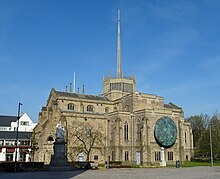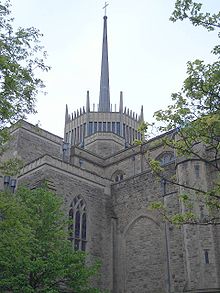Blackburn Cathedral
| Blackburn Cathedral | |
|---|---|
| Cathedral Church of St Mary the Virgin with St Paul | |
 The Cathedral from the west | |
| 53°44′50″N2°28′53″W/ 53.7473°N 2.4813°W | |
| Location | Blackburn, Lancashire |
| Country | England |
| Denomination | Church of England |
| Website | www |
| History | |
| Consecrated | 1977 |
| Architecture | |
| Architect(s) |
|
| Style | Gothic Revival |
| Years built | 1820–1967 |
| Administration | |
| Province | York |
| Diocese | Blackburn(since 1926) |
| Clergy | |
| Bishop(s) | Philip North |
| Dean | Peter Howell-Jones |
| Canon(s) | Canon Dr Jenny Gaffin (CanonPrecentor) |
| Canon Missioner | Canon James Lawrence |
| Laity | |
| Director of music | John Robinson |
| Organist(s) | John Hosking (Organist in Residence) |
Listed Building– Grade II* | |
| Official name | Cathedral Church of St Mary the Virgin |
| Designated | 28 November 1951 |
| Reference no. | 1239147 |
Blackburn Cathedral,officially known as theCathedral Church of Saint Mary the Virgin with Saint Paul,is anAnglican(Church of England)cathedralsituated in the heart ofBlackburntown centre, inLancashire,England. The cathedral site has been home to a church for over a thousand years and the first stone church was built there inNormantimes.
History[edit]
With the creation of theDiocese of Blackburnin 1926 (taken from theDiocese of Manchester), the impressive parish church of St Mary the Virgin was raised tocathedralstatus. The church, which was built in 1826 and designed by architectJohn Palmer,now forms the cathedral's nave. It replaced the parish church that was demolished in 1819–1820.[1]
In the early 1930s, fundraising began to enlarge the cathedral so that the building complemented its newfound importance. By 1938, enough money had been raised and work began on enlarging the new cathedral. Although work was interrupted bythe war,it was resumed afterwards and continued through the 1950s and into the early 1960s. After the death of architect W.A. Forsyth in 1950, architect Laurence King joined the project and designed the distinctivelantern tower.The lantern tower, which consists of 56 different panes of coloured glass, with amodernistslenderaluminiumspire, was completed in 1967.
The cathedral was finally completed in 1977 and what had been built over the past decades was finally consecrated as Blackburn Cathedral that year.[2]
The north transept contains eightmisericordsdating from the 15th century. It is not known at what time they arrived at the cathedral, but they are believed to have originated atWhalley Abbey.This could mean that they were removed to a builder's yard after theDissolution,but with the cathedral not being built until the 19th century, this allows for the possibility that they had lain unused for some 300 years.
On 17 April 2014, the cathedral hosted theRoyal Maundyservice. In keeping with tradition,Elizabeth IIhanded outMaundy moneyto 88 men and 88 women. It was the Queen's first visit to the cathedral.[3]
It was reported inThe Treasury,aPresbyterian Church of Walespublication, that a historic sharing agreement between the chapter of Blackburn Cathedral with a local Welsh Presbyterian congregation of the lady chapel will take place in 2023. This is believed to be the first covenant of its kind between a cathedral and non Anglican denomination.
Dean and chapter[edit]

As of 30 November 2020:[4]
- Dean—Peter Howell-Jones(since 25 March 2017 installation)
- Canon Missioner — James Lawrence
- Canon Precentor — Jennifer Gaffin
Music[edit]
The organist and director of music isJohn Robinson[5]and the organist in residence is John Hosking.[6]
Choir[edit]
The cathedral choirs — Cathedral Choir of Boys, Girls and Men, Youth Choir - formally Young Peoples' Choir, Blackburn Chamber Choir, formally Renaissance Singers/the Bach Choir and St Paul’s Singers. On Sundays the Parish Communion is sung by the YPC and the Eucharist and Evensong by the Cathedral Choir.
Organ[edit]
The organ for the new church was designed byJohn Gray and Frederick Davison.Its debut was on 28 February 1828, with a concert of works byHandelincluding extracts from theMessiah,Israel in Egyptand hisOccasional Overture,played by the new organistJoseph John Harris.[7]This organ was replaced in the 1870s by an instrument designed byAristide Cavaillé-Coll.[7]
The third, and present organ at Blackburn was built byJ. W. Walker & Sons Ltdand completed in 1970. Funding was provided by William Thompson, a Burnley-based benefactor of the cathedral. The organ was restored at the end of the 20th century by Woods. It is considered a world-class instrument, and is used for recordings, concerts, recitals and organ meditations throughout the year.[7]
Organists[edit]
Since 2019 the organist and director of music has been John Robinson. Previous organists have includedHenry Smart,Richard Henry Coleman,Charles Hylton Stewart,Herman Brearley,Thomas Lucas Duerden,John Bertalot,David Anthony Cooper,Gordon Stewart,Richard Tanner and Samuel Hudson. The organist in residence (since 2022) is John Hosking.
Bells[edit]
The first mention of bells in the old parish church was in 1552 when the vicar and churchwardens purchased five bells from the Royal Commissioners for £26-12-1. A new peal of six bells was cast in 1737 from the metal of the existing bells and it was this ring of six that was moved over to the west tower of the new church in 1832. Four bells were added during 1851–52 to form a ring of ten.
In 1949, while extension work was being carried out in the cathedral, the current ring of ten bells was installed. All ten bells were cast by John Taylor & Co. ofLoughborough.The tenor bell weighs 25-1-14 (1,289 kg) is tuned to D and has a diameter of 52 inches (1.32 metres).[8]
Recent developments[edit]
In 1998 the lantern tower underwent restoration, being rebuilt in natural stone. The original 1960s tower had been constructed in concrete. The windows were also replaced.
Further work was carried out in 2000–01 to re-build the east end roofs and parapets and blend them into the existing structures. Upon completion of this work, the cathedral was finally deemed to be finished after over 70 years of construction.
As well as this rebuilding, a new piece of art was commissioned for the exterior of the building. The sculpture by Mark Jalland,The Healing of The Nations,measuring 35 by 26 feet (10.7 m × 7.9 m), is an abstract steel and copper circular piece containing thousands of interwovenfibre opticsthat create ever-changing patterns of light at night. It is deemed by many to be one of the most innovative pieces of modern sculpture at any English cathedral.
In 2009 the flagpole was replaced with one carved by Mark Bridges. It is topped with abishop's mitrefinial,painted and gilded ingold leafwith theLancashire Roseemblem. The majority of the funding came from a bequest by Harold Thornber, who had worked at the cathedral as a warden and archivist[9]
The cathedral still forms an important part of the community. It is open to visitors and has a café as well as hosting numerous events. In February 2011, the cathedral exhibited theQuaker Tapestryfrom Kendal.[10]
In 2021, the crypt of Blackburn Cathedral was used as a major public vaccination centre againstCOVID-19.[11]
Gallery[edit]
-
The Nave, looking east
-
The Nave, looking west
-
The Sanctuary
-
View of Transept and Sanctuary, showing the organ
-
Interior view of the Lantern
-
East end:RoodbyAdvent Hunstone,seen beyond the hanging corona by John Hayward
-
West end:Worker Christby John Hayward
-
Sculpture:The Healing of The Nationsby Mark Jalland
-
The tower, 2011
-
Part of the ceiling in the Southtransept
-
One of the misericords
See also[edit]
References[edit]
- ^Hartley, Gordon (29 January 2019). "Tracing the history of long-lost market cross".Lancashire Telegraph.p. 22.
- ^"Blackburn Cathedral | Scala".Scalapublishers.Retrieved23 June2015.
- ^"Maundy Thursday: Queen hands out money at Blackburn Cathedral - BBC News".BBC News.17 April 2014.Retrieved23 June2015.
- ^Blackburn Cathedral — Who's Who(Accessed 30 November 2020)
- ^"Director of Music".Blackburncathedral. Archived fromthe originalon 9 July 2015.Retrieved6 July2015.
- ^"Shaun Turnbull".Blackburncathedral. Archived fromthe originalon 8 July 2015.Retrieved6 July2015.
- ^abcJohn Bertalot and Richard Tanner."The Organs of Blackburn Cathedral"(PDF).blackburncathedral /. Archived fromthe original(PDF)on 25 February 2014.Retrieved12 February2024.
- ^Central Council of Church Bell Ringers.Dove's Guide for Church Bell Ringers.Central Council Publications.Retrieved25 December2022.
- ^"New ornate mitre tops off tower at Blackburn Cathedral".Lancashire Telegraph.7 October 2009.
- ^"Quaker Tapestry Exhibition at visitlancashire".Archived fromthe originalon 17 July 2011.Retrieved16 February2011.
- ^"Home | Lancashire Evening Post".
Further reading[edit]
Canon Chris Chivers.Blackburn Cathedral.Scala Arts Publishers.ISBN978-1-85759-645-8.
External links[edit]
- Anglican cathedrals in England
- Churches in Blackburn
- Church of England church buildings in Lancashire
- Tourist attractions in Blackburn
- Diocese of Blackburn
- Gothic Revival church buildings in England
- Gothic Revival architecture in Lancashire
- Grade II* listed buildings in Lancashire
- Provosts and Deans of Blackburn
- Grade II* listed cathedrals
- Basilicas (Church of England)












